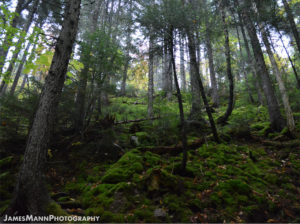Knock on wood—NB forests might get the protection they need

The nature of New Brunswick is nothing short of astounding—with coasts on three sides, expansive winding rivers, and more than 200 lakes, this province is home to all kinds of ecosystems, habitats, and landscapes. But what most people think of when it comes to New Brunswick’s backdrop are the trees. When people visit for the first time they are struck by the lush green mixed forests that dominate the landscape, making day trips more scenic and wildlife so abundant.
The forests of New Brunswick build deep roots for culture, biodiversity, and the economy. They provide all kinds of important services to New Brunswickers: storing carbon and helping to reduce impacts from climate change; helping to cycle the nutrients that all life depends on; preventing flooding by holding water in their soils, and creating a sense of ease, happiness, and spirituality for the masses. Two of New Brunswick’s major industries, tourism and forestry, depend on our vibrant and resilient forest. It is without doubt that forests are among the most important resources in New Brunswick, and therefore should be managed with the utmost care.

Forests and forestry products are a renewable resource, which means that with proper management and a keen eye for sustainable use the industry can persist. Unfortunately, this seems to be easier said than done. All over the world in all sorts of industries, renewable resources are being depleted faster than they can recover and reproduce. We have not yet come to terms with the role of climate change in the management of forests. This can lead to unsustainable management that creates risk for industries and for the families, communities, and economies depending on their success.
When it comes to forests, sustainable management ensures that the industry can prevail, while also safeguarding forest ecosystems for the many other benefits they provide. CPAWS-NB looks to the important link between conservation and sustainable industry when it comes to the forests. When forests are protected from industrial development and extraction, they become more resilient and safeguarded against the unknown. Protected forests will continue to deliver the non-forestry benefits that are lost when trees are harvested, ensuring a productive forest ecosystem now and in the future.

This summer, the New Brunswick Department of Energy and Resource Development released a revised Forest Strategy that will, among other management strategies, allow the province to re-build commitments to conservation. The revised Strategy might open the door for increasing protected area coverage, which is currently only 4.6% of the province. CPAWS-NB is optimistic that this Strategy is a good start to building a foundation for conservation and hopes that the province will go further to make forest integrity and resilience an urgent priority in forestry management.
As put by the CPAWS-NB Executive Director, Roberta Clowater, “a modern Forest Strategy needs to have a serious insurance policy of significant areas where nature is permanently protected from industrial development.” Listen to an interview with Roberta on the Strategy and forest conservation in the province here.
As the provincial election approaches, consider New Brunswick’s forests before you cast your ballot. Remember that, as a province, we need to be working together to create a healthy industry rooted in a healthy forest, and this will mean a serious investment in protected areas.
Check out a message from our Executive Director on using your voice and vote for nature on September 24.

